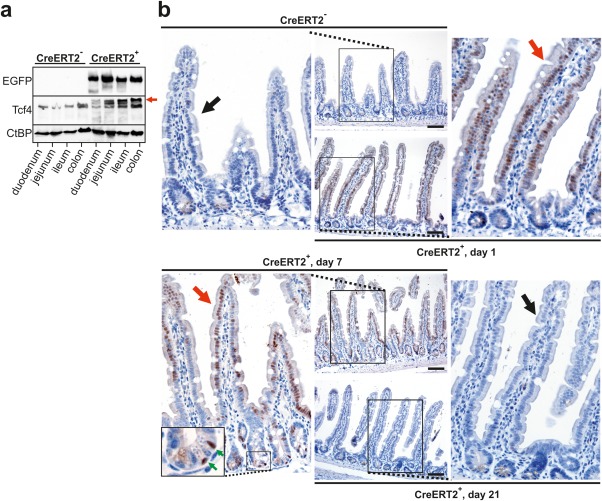Figure 3.

Transitory production of EGFP‐dnTCF protein in the intestine of Rosa26tdTomato/tdTomato/Villin‐CreERT2+ mice. Notice that in these mice EGFP‐dnTCF4 can be produced from both Rosa26 alleles. (a) Immunoblotting analysis using cell lysates prepared from the indicated parts of the intestinal epithelium of Rosa26tdTomato/tdTomato (CreERT2‐) and Rosa26tdTomato/tdTomato/Villin‐CreERT2+ (CreERT2+) mice one day after a single dose of tamoxifen. Notice that whereas an anti‐TCF4 antibody detected both endogenous Tcf4 and transgenic EGFP‐dnTCF4 protein (red arrow), the EGFP‐specific signal was visible in CreERT2+ animals only. Immunoblotting with an antibody recognizing C‐terminal binding protein (CtBP) was used as a loading control. (b) Immunohistochemical detection of EGFP‐dnTCF4 protein in the jejunum of CreERT2‐ and CreERT2+ mice using an EGFP‐specific antibody and 3,3'‐diaminobenzidine (DAB) staining (brownish precipitate); specimens were counterstained with hematoxylin (blue nuclei). CreERT2+ mice were sacrificed at days 1, 7, and 21 upon tamoxifen administration. Notice the positive nuclei of villus epithelial cells at days 1 and 7 (red arrows) and diminished nuclear EGFP‐dnTCF4 positivity in the intestinal epithelium of CreERT2‐ mouse or in CreERT2+ animal sacrificed at the last time point (black arrows). Green arrows in the inset placed in the bottom left image point to labeled Paneth cells. Scale bar: 0.15 mm.
